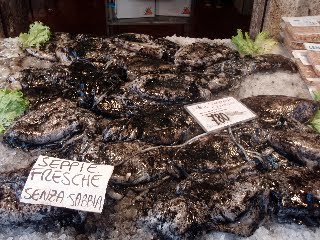Seppie (Sepe) in Umido alla Veneziana (Black Cuttlefish Venetian Style)
/I saw a video yesterday by Cesare Colonnese about the Seppie in Umido and decided to prepare them today for lunch so went to Rialto market to get fresh Cuttlefish (Seppie)
This requires fresh cuttlefish, because you will need the contents of one or two ink sacks. It makes an excellent one-course meal if served with either fresh polenta, which is the traditional Venetian accompaniment, or a simple risotto in bianco

Ingredients:
- 2 1/4 pounds (1 k) medium-sized cuttlefish, with their ink sacks
- 1 clove garlic
- 1 medium onion, finely minced
- 1 tablespoon minced parsley
- 1 cup (250 ml) dry white wine
- 2 teaspoons tomato paste
- 1 cup (250 ml) hot broth or bouillon
- 1/2 cup (125 ml) olive oil
- Salt to taste
Preparation:
Clean the cuttlefish, setting aside two ink sacks. Wash the cuttlefish well, cut the bodies into thin rings, and chop the tentacles. Set a pot on the fire and sauté the onion and garlic in the olive oil, over a brisk flame. When the onion is lightly browned remove and discard the garlic, then add the cuttlefish to the pot, salt them lightly, and stir in the parsley Continue sautéing for ten minutes, stirring all the while, then add the wine and bring the mixture to a simmer. Remove the ink from the sacks to a bowl, and add it to the cuttlefish according to your taste – in other words, if you want a very dark dish add all the ink. Stir in the tomato paste as well, and continue simmering over a low flame until the cuttlefish is fork tender (45-50 minutes), adding the hot broth as need be to replace the liquid that evaporates. Check seasoning and serve, in an elegant pre-heated dish.












